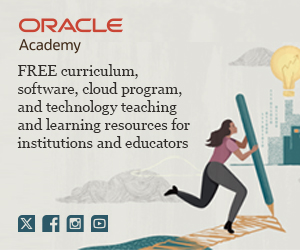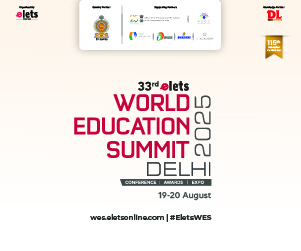City students part of UIDAI project The unique identification project started by the Unique Identification Authority of India (UIDAI) in 2006 finds home gems Samarth Bharadwaj and Himanshu Bhatt part of a team of students from IIIT-Delhi , who are working and contributing to it. Both second-year research students at the Indraprastha Institute of Information Technology (IIIT), Delhi have been working hard on the project which is an initiative to provide and uniqueness every individual to avoid duplicity and fake identities. Bharadwaj had begun working on the project last year and there are four research students from IIIT who are conducting a feasibility study on finger prints of labourers and farmers
The unique identification project started by the Unique Identification Authority of India (UIDAI) in 2006 finds home gems Samarth Bharadwaj and Himanshu Bhatt part of a team of students from IIIT-Delhi , who are working and contributing to it. Both second-year research students at the Indraprastha Institute of Information Technology (IIIT), Delhi have been working hard on the project which is an initiative to provide and uniqueness every individual to avoid duplicity and fake identities. Bharadwaj had begun working on the project last year and there are four research students from IIIT who are conducting a feasibility study on finger prints of labourers and farmers
News India- April 2011
Aveco&rsquo:s Delivery on IWB Pitch
 Sandeep jain
Sandeep jain
Managing Director
Aveco Technologies Pvt Ltd
Passionate about providing innovative products and services and fulfilling the unmet needs of the customers, Aveco's offers include the most basic features to the most sophisticated technology which are for the customer's benefit and substantial value
Established in 1992, Aveco Technologies Private Limited is located at Secunderabad. Incorporated in 1995, Aveco is driven by strong focus on value, quality and integrity. The well-nurtured and loyal network of strong and dedicated dealers spread across country give strong relationship with consumers and are the foundation for future growth. The wealth of knowledge and international expertise to the service of local consumers aim to add liveliness to life. Everyday needs for presentation, communication and interactive solution are met with brands that help people see good, present good, feel good and get more out of life. Dealing in products, which are designed to stand the test of time, offer supreme ease of use and represent extraordinary value for money.
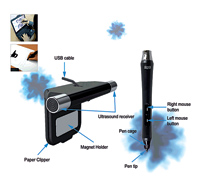 The use of interactive whiteboards in schools is gaining in popularity, giving more teachers than ever before access to this technology. Interactive whiteboards add new dimensions to instructor-led classroom delivery, enrich content with multimedia, simulations and games, manage content, provide classroom connection to the web and save presentations for use as podcasts for remote students. These and many other capabilities are available with modern, touch-sensitive electronic whiteboards!
The use of interactive whiteboards in schools is gaining in popularity, giving more teachers than ever before access to this technology. Interactive whiteboards add new dimensions to instructor-led classroom delivery, enrich content with multimedia, simulations and games, manage content, provide classroom connection to the web and save presentations for use as podcasts for remote students. These and many other capabilities are available with modern, touch-sensitive electronic whiteboards!
The interactive white board, the projector and the computer when integrated together with audio becomes a very powerful tool in the hands of the teachers to impart effective learning through visualisation and active involvement of the students. Teachers have found that increasing pupils' exposure to white boards significantly and positively impacts pupil achievement and teacher preparation.
Students' participation becomes a powerful reinforcement and review activity because they are hearing the concept explained at their learning level through visual media. Interactive white board engages students in learning. Watching a presentation becomes interactive when the teacher is able to pause the presentation, point out details and add in her own notes to the presentation.
Reviewing for a test is easier when the teacher captures the instruction both audio and visual form. Students can play and re-play the lesson in video format. Tied up with one of the best manufacturers of interactive whiteboards and customising the product as per the best of requirements in today's classrooms, it caters the segment with refined product “Aveco e-Guru” interactive board which has been one of the successful products well accepted by the education industry. The technology and the software are furnished to the level where tutor can make his own interactive presentation as per the ease of understanding and the better memory retention of the students in classroom.
Deep diving into the interactive segment, the technological biggie has come up in the market with the tools that convert any of the existing surface into interactive. Tied up with Pen N Free (PNF) the technology-oriented company providing an innovative MMI (Multimedia Interface) solution for more natural interaction between humans and computer, Aveco has come up with the solution of having the range of products that can convert your display device interactive starting from minimum of 15″ to maximum of 120″ in diagonal. These devices also convert professional displays and the LCD monitors into interactive surface.
Promising Future with Promethean Activboard
Activboard caters to today's classroom needs with enhanced interactive whiteboard technology, coupled with apt software and the facility to respond as active participants in the lesson
Promethean believes that technology holds the power to unleash the potential of human achievement. As the global leader in learning technology, Promethean combines innovation, real-world experience, scientific insight and thought leadership to help realise the fullest potential of every instructor, presenter and student everywhere
Hitachi&rsquo:s StarBoard, FX TRIO Ruling IWB Market
 Tarun Jain
Tarun Jain
Country Head
With technology advancement in Interactive WhiteBoards, Hitachi is delivering the best digital learning equipment in the form of StarBoard and multiple user accessible FX TRIO 77 and 88
Hitachi Limited, headquartered in Tokyo, Japan, is a leading global electronics worth 100 billion dollar company with approximately 400,000 employees worldwide and having expertise across sectors like information systems, electronic devices, power and industrial systems, consumer products, materials, logistics and financial services.
 Hitachi offers advanced interactive whiteboards, cutting-edge LCD projectors and premium LCD and LED televisions.
Hitachi offers advanced interactive whiteboards, cutting-edge LCD projectors and premium LCD and LED televisions.
Hitachi is also a world leader in the LCD projector space, including ultra and ultimate -short throw projector technology which virtually eliminates shadows. For more information visit www.hitachiconsumer.com/in
Hitachi StarBoard: Reliable Interactive WhiteBoard Technology
Powered by the most advanced presentation software available
Innovative Education Concepts
 IE Concepts is a new initiative in education, with ideas to spearhead the change in education in India. The aim of the initiative is to be well recognised in the education field for the quality of services and training provided to various schools across India. Their objective is to be a part of the change in the education trend in India
IE Concepts is a new initiative in education, with ideas to spearhead the change in education in India. The aim of the initiative is to be well recognised in the education field for the quality of services and training provided to various schools across India. Their objective is to be a part of the change in the education trend in India
By Sudarshan Borker
Innovative Education (IE) Concepts works with schools to provide low cost IT solutions to set up interactive learning centers for language labs, math lab, other applications and smart class solution. It helps improve teacher's teaching skills and develop new innovative educational products which will help in changing the current education trend that has been followed for years.
IE Concepts conduct seminars for principals and teachers to enable them stay abreast with new practices evolving in education and teaching methodologies and make schools aware of ICT in education.
Products of IE Concepts: EduPc
EduPC is a low cost computing device which lets schools set up language labs, math labs or an interactive learning center at cost effective prices which requires multiple computers. The technology eliminates the use of multiple desktop computers environment replacing to a consolidated client-server computing model, hence reducing the overall set up cost by 50 per cent. These units have no moving parts or internal hard-disk as the data is stored on the server and the access to certain applications can be restricted to the users. Overall in the long run, there is no need for system replacements or system updates. The server is the only hardware which needs to be updated.
The system supports over 30 users on a CPU server setup, as per user configuration. It consumes less power as compared to desktop units, thus reducing energy cost and air conditioning usage. It also has rich multimedia playback for video files and high quality audio and animation. Investment cost to set up desktop units is reduced by 50 per cent and long term operations cost saved by 75 per cent. The solution is compatible with other learnings and supports Windows.
What is IE Class?
IE Class is one-of-its-kind product for leveraging the power of web with its simple user interface, allowing the instructor to teach using a wide variety of media. These include audio and video playback, web browser and access to YouTube educational videos, all displayed through a data projector or on a LCD screen. The device is used as a stand alone unit in schools where they opt for just one or few units where purchase of server is not required. It would support all features as a networked setup and the content would have to be stored on an external device. Compared to a desktop computers, the solution eliminates applications that are hardly used in the classroom. The devices add value to the technical aspect of the class setup and also makes it easier for the user.
With competitive features and low cost, the solution gives schools the liberty to setup their own infrastructure and load relevant content for use.
|
Benefits of EduPC
|
The British School
IWB is the basis for a transformed pedagogy of real time teaching, inclusive and extended learning. It is now an integral part of the learning process- is to be used as a tool, as and when necessary
By Deepti Sawhney
The British School, New Delhi is a centre of Excellence for the Promethean AvtivBoards. The journey to this effect was filled with learning experiences, both for the staff and the students. We took the Interactive Boards plunge in 2007-08 and slowly phased them in. By 2009, we had an IWB in every classroom and in 2010, having trained staff and achieved the required training levels; we were awarded the Centre of Excellence from Promethean, UK.
The British School aims to make ICT an integral part of the learning process-to be used as a tool, as and when necessary. The curriculum advocates “when to click” rather than “what to click”. With a repertoire of technologies available at hand, the students need to judiciously decide what to use and when, taking decisions after analysing various options, being a part of the critical thinking mantra we advocate. There is an array of material available that is compatible with the Promethean IWB. Externally produced material May or May not match the planning and the flow which learning takes. Some kinds of alterations are required to match various dimensions like the time frame, daily planning and of course, the ability differences in the classroom.
Innovation Lies in the Key
The teaching process has changed over time and has evolved keeping in mind, the changing trends and demands of society. The students are no longer taking in information without processing and without asking the question-why? Thus, arises the need to innovate. Innovation requires a teacher who has the vision, expertise, conviction and the strength to pull it through. A huge amount of importance is given to the emergence of ICT in education as it does have the power to innovate. The motivation that the area provides further enhances the probability of using it as a hook to impart learning.
Towards 21st century Learning
The major benefit of the IWBs is of course, the interactivity! They synchronise together the teacher, the student and the teaching medium and makes learning active and alive. If the teaching-learning activity is planned prudently, it allows students to work together around a shared task, thus advocating and supporting collaborative learning. Skills like critical thinking, creativity, global awareness, initiative and self-direction are some of the student outcomes that are identified by Partnership for 21st Century Skills. The IWB can deftly facilitate all that.
Staff Training-Continuous Professional Development
Staff training for the IWBs is an on-going process. The school has a professional Learning Community which learns by sharing strategies that work and also those that should be avoided. What really bought the idea in was the fact that the staff found the IWBs to be highly motivating and learner-centric. And also, that the working area of a Promethean IWB is very similar to the conventional whiteboard. Even the very techno challenged teachers are at ease using the ActivPen. All teaching staff is required to clear Level 1 certification within 6 months of joining to ensure that we maintain the standard of lesson delivery.
Content Development
The school follows National Curriculum of England with adaptations to enrich it, relevant to the Indian locale. The staff makes their own lesson content as they know what suits their class best. IWBs lessons are saved as a resource database to be shared, analysed and reflected upon by the teaching community-within and outside school. A lot of flipcharts are available on Promethean Planet, a forum where teachers across the world share ideas and lessons. As the years progressed, the school has accumulated a huge wealth of resources which can be tweaked and used, year after year.
Real-time Teaching
With the resources readily available at hand (provided software), teachers can quickly alter lessons to flow with the needs of the class during real time teaching. A huge amount of activities can be designed to inculcate decision making (associate sound with pictures), problem solving and creativity (2Draw). IWBs along with suitable software and appropriate planning can make abstract concepts of science and numeracy a visual treat. They enhance the lessons with vibrancy of multimedia-which can address all learning styles and intelligences. They are great for all the stages of a lesson-be it the lesson starter or the plenary. Or it can be used just for display, for example, promoting reading by showcasing e-books on screen makes the books come alive. And students can interact with the story by annotating, recording voice-over, twisting traditional tales-the list can go on.
Sharing the Learning
Working with IWBs encourages students to overcome any fear of handling technology. As the IWB basically displays hardware, the students use it for sharing their work, presenting results, making rubrics, doing peer-assessment and showcasing their research. The interactivity of the board makes the students feel in-charge and in full control. The empowerment boosts their confidence level and in the peer-assessment sessions, tactful delivery of observations and positive criticism have been given and received amicably!
Peripherals that Enhance the Experience
Teachers and students using the IWB can be sufficiently mobile, unlike working on the computer. Mobility can be improved further by using peripherals like wireless keyboard and mouse, ActiVote, ActivExpression, etc. ActivSlates facilitate classroom engagement from any corner of the room. This wireless, fully integrated tablet encourages classroom engagement and takes student participation to another level.
Besides, the web-cam attached to the IWB can be used to showcase science experiments, slide observations and art brush strokes.
Assessment
The IWB supports a vital strand of ICT in the National Curriculum- Reviewing, modifying and evaluating work as it progresses. Several versions of work with annotations can be saved for the students to critically evaluate their work and also reflect on their responses. The IWBs used with learner response systems (ActiVote) show immediate feedback, thus endorsing feedback being timely and immediate. ActivExpression is also a LRS device which helps to make assessment a self-reflection process.
EDGE 2011:
 Inaugurated for the period of three days (9-11th March 2011), at Indian Habitat Centre, New Delhi, the Edge Forum came up with agenda to shape the future of youth with Higher Education
Inaugurated for the period of three days (9-11th March 2011), at Indian Habitat Centre, New Delhi, the Edge Forum came up with agenda to shape the future of youth with Higher Education
By Pragya Gupta
Started in 2007, EDGE conference is taking its legacy forward year on year by taking Higher Education to next level of intensification.
To speak on ‘Shaping the Future of Indian Higher Education’ EDGE 2011 conference brought together a constellation of stars including Vice-Chancellors, Presidents, Directors, Professors, Education Councils, Entrepreneurs, policy makers and Union ministers to interact, collaborate and understand the prevailing trends in the Higher Education sector.
Inaugurating the conference, Kapil Sibal, Union Minister for HRD and Communications and Information Technology, Govt of India said, “India is poised to become the ‘centre of gravity in global Higher Education. We are at the cusp of next revolution in education in India and more investment in Higher Education is the only way forward. Financing education is a government commitment and our national duty with no strings attached. What we need is a change of mindset among all stakeholders in the Higher Education sector. We must also ensure that the profession of teaching gets highest priority.”
Dignitaries present during inauguration are Dr. Shashi Tharoor, Member of Parliament, Lok Sabha, Prof C.N.R. Rao, Chairman, Science Advisory Council to Prime Minister, National Research Professor and Linus Pauling Research Professor and Honorary President, JNCASR, Bangalore, Dr Ayoub Kazim, MD, Dubai Knowledge Village and Dubai International Academic City, Prof Bertil Andersson, Provost, Nanyang Technological University, Ajit Gulabchand, Chairman, Lavasa Corporation, Dr V.S. Ramamurthy, Director, National Institute of Advanced Studies (NIAS), Prof V.N. Rajasekharan Pillai, Vice Chancellor, IGNOU, Dr S.B. Mujumdar, Chancellor, Symbiosis International University.
Prof C.N.R. Rao, well-known educator, scientist and institution builder was honoured with the EDGE Education Personality of the Year Award to recognise his extraordinary and exemplary contribution to Higher Education sector. While receiving the award, Prof Rao focussing on the need and value of teacher-student interaction commented, “Absence of teacher or direct teaching totally based on ICT will not improve education standards in India. Thus our deliverables to the students must be unconditional.”
Madan Padaki, Co-Founder and CEO, MeritTrac Services Pvt. Ltd. has won Young EDGE Award 2011 for having demonstrated leadership in the education sector with significant contribution to the field of Higher Education.
As 40 million youths look for Higher Education by 2020 compared to 17 million currently, the sector needs to act now to fully exploit our demographic potential. Higher Education would need one million faculties to teach them and would need more than 504 universities that are present now. According to the estimates of Ernst and Young, the sector would require nine lakh crore in investments. Stakeholders in the sector need to explore various options to achieve the government set target of Gross Enrolment Ratio of 30 per cent by 2020 from the present 13.5 per cent.
S.B. Mujumdar, Chancellor, Symbiosis International University and Patron of EDGE Forum said, “The idea of EDGE conference is to connect good institutions and universities in India to collaborate and co-operate and find solutions for many challenges in our country. We intend to bridge the gap between government, colleges and universities which will speed up the process of expansion and inclusion in the Higher Education sector in India.”
Prof V.N. Rajasekharan Pillai, Vice-Chancellor of IGNOU and Academic Programme Committee Chairman of EDGE 2011, said, “EDGE is the foremost platform for the stakeholders in Higher Education sector in India and the world to converge. Interactions at the platform will help us act together towards identified goals with a beneficial intent for the education sector.” The other stalwarts who addressed the conference include D. Purandeswari, Hon’ble Minister of State for Human Resource Development, Govt of India, Rajesh Ankushrao Tope, Hon’ble Minister for Higher and Technical Education, Government of Maharashtra, Dr Narendra Jadhav, Member, Planning Commission, Vibha Puri Das, Secretary (SE and HE), Dept. of Higher Education, Ministry of HRD, Govt of India, Amit Khare, Joint Secretary, Department of Higher Education, MHRD, Govt of India; Marlene M. Johnson, Executive Director and CEO, NAFSA.
The conference has also covered various critical topics for the sector like International Partnerships, Future of Medical Education, Vocational Education, Education Infrastructure, Funding Education, Frontiers of New Assessments, ICT for Next Generation Learning Environments, Creativity in Higher Education, Medical Education and Education Policy Framework.
Four workshops were conducted covering diverse topics like “New Models of Admissions” by the College Board, USA; “Governance Issues in Educational Institutions” by IIM-Bangalore; “Making International Partnerships Work” by Symbiosis and “What it takes to be in Top 100?” by QS Apple.
More than 30 international institutions from USA, France, Singapore, Australia, Dubai and Canada are exploring partnerships with Indian Institutions. The workshop on “Governance Issues in Educational Institutions” has discussed various issues and solutions. The event also consists of EduExpo for Educational Institutions, Publishing Houses, IT Companies and other service providers.
Sessions on Education Infrastructure, Critical Aspects in nurturing International partnerships, Mainstreaming VET for Sustainable Growth, Funding Education in Emerging Market- discussing on various financing option available including mobilising alumni for funding, contingent loan mechanism for students and then sessions on Future of Medical Education, Developing Competence: The Role of Creativity in Higher Education discussed various important aspects of Higher Education.
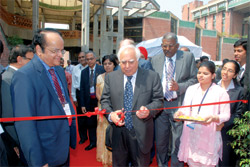 Prof Rajasekharan Pillai, Vice Chancellor, IGNOU & Kapil Sibal, HRD Minister, Govt of India
Prof Rajasekharan Pillai, Vice Chancellor, IGNOU & Kapil Sibal, HRD Minister, Govt of India
The final panel discussion on government policy frameworks to encourage, enrich and enhance the sector was driven by Oscar Fernandes, MP, Rajya Sabha, Dr Narendra Jadhav, Member of Planning Commission, Dr G. Viswanathan, Chancellor, VIT University, Amitabh Jhingan, Partner, Ernst and Young India and Anand Sudarshan, CEO and MD, Manipal Education.
|
VIT, State University of New York Binghamton Sign MoU VIT University, Vellore, India has signed MoU into a formal academic and research cooperation with State University of New York (SUNY) at Binghamton, USA during the Edge 2011 conference for 5 years with a provision for extension on mutual consent. Through this co-operation both universities will work jointly on activities such as establishing joint research activities, joint supervision of Ph.D students, faculty exchanges, exchanging information of interest such as publications and project documents, student exchanges and collaborative delivery of degree programs. |
ICISTM-2011
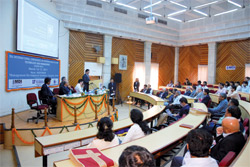 Management Development Institute (MDI) in association with University of Florida, USA and Grenoble, EU, France, organised the Fifth International Conference on Information Systems, Technology and Management
Management Development Institute (MDI) in association with University of Florida, USA and Grenoble, EU, France, organised the Fifth International Conference on Information Systems, Technology and Management
We are amidst an information age where the rate of growth and complexity of data collected is growing exponentially, fuelling demands for effective and efficient information management, technology and systems solutions which are required in every industry today. ICISTM-2011 aims to bring together researchers, developers and practitioners from around the world in academia and industry for sharing state-of-the-art results and for exploring new areas of research and development in the knowledge economy.
The inaugural session witnessed a very enlightening thought exchange by Dr Andrew Lim, Head and Professor, Department of Management Sciences, College of Business, City University of Hong Kong. He spoke about the importance of the business value model and measuring KPIs effectively. Purchasing IT packages is essential, but to implement effectively is of paramount importance.
Prof Sartaj Sahni and Dr Renaud Cornu Emiux from the University of Florida and Grenoble EU respectively, which are the partner Institutes with MDI for ICISTM 2011, also spoke about the importance of research work in IT.
The conference attracted a large number of research papers from India, US, Europe and Africa. The papers presented by the authors under various tracks included Information Systems, Information Technology, Business Intelligence, Information Management, Health Information Management and Technology and Applications of Information Systems.The basic focus of Prof Prem Vrat’s (Professor ofEminence—MDI) sessionwas on the knowledge society and itsedge to India due to demographic dividendand IT strength.
Besides the wisdomhierarchy, the knowledge societyshould ultimately be based on wisdomfor the good of the society and also interprethuman values in technology. However,there are various challenges thathurdle in the process.Dr Sanjay Ranka (Professor in theDepartment of Computer Information Science and Engineering at University ofFlorida, USA) spoke on he “Energy andthermal efficient multicore computing”and pointed out the areas of concern which include rising temperature, glaciers receding, projected risks – extinctions, population, area and economy (GDP) affected by 1m sea level rise, ICT impact on carbon dioxide emissions, carbon dioxide emissions comparable to aviation industries, cost of cooling, cost of cyber infrastructure, efficient ICT methods – reduce total emissions by 15 per cent – climate group and global e-sustainability report. 22 per cent – BCG for US, volution of multicore processors are the new workhorses – high power density doubles every three years and need for thermal optimisation.
He further added that the main job is to develop an integrated framework for multicore that addresses computation, energy and temperature. Dr Sumeet Dua (Upchurch Endowed Professor, Associate Professor and Graduate Coordinator of Computer Science Louisiana Tech University, USA) later spoke on the “Associative Learning Algorithm Framework in Data Mining” The agenda of the session included data mining principles – importance on business applications, associative and correlation based learning, applications, image mining, protein classification, data mining – extraction of interesting information or patterns from data in large databases or other information repositories. Prof Renaud Cornu Emieux, from Grenoble EM, France highlighted four powerful worldwide changes that have altered the business environment. These changes in the business environment and climate, pose a number of new challenges to business firms and their management. A growing percentage of the American economy – and other advanced industrial economies in Europe and Asia – epend on imports and exports. Foreign trade, both exports and imports, accounts for more than 25 per cent of the goods and services produced in the United States and even more in countries such as Japan and Germany. Companies are also distributing core business functions in product design, manufacturing, finance, and customer support to locations in other countries where the work can be performed more cost effectively. The success of firms Today and in the future depends on their ability to operate globally. The United States, Japan, Germany, and other major industrial powers are being transformed from industrial economies to knowledge – and informationbased service economies, whereas manufacturing has been moving to lowwage countries. In a knowledge and information based economy, knowledge and information are key ingredients in creating wealth. There has been a transformation in the possibilities for organising and managing the business enterprise. Some firms have begun to take advantage of these new possibilities. he traditional business firm was – and still is – a hierarchical, centralised, structured arrangement of specialists that typically relied on a fixed set of standard operating procedure to deliver a mass-produced product (or service). The new style of business firm is a flattened (less hierarchical), decentralised; flexible arrangement of generalists who rely on nearly instant information to deliver masscustomised products and services uniquely suited to specific markets or customers. Intensive use of information technology business firms since the mid-1990s, coupled ,
the rise of information economies and the growth of the internet have recast he role of the business managers in managing information resources
with equally significant organisational redesign, has created the conditions for new phenomenon in industrial society -–the fully digital firm. The primary oncern of Information Management, in the enterprise today, is to ensure that the knowledge necessary to drive critical business processes is available where it needs to be, when it needs to be. The costs of failure to do this are high. If we just have a re-look at the emerging complexities and dynamic nature of the business, we find that the globalisation of business. Internet technology is upplying the foundation for new business models, new business processes, and new ways of distributing knowledge.
Cybernetyx Bridging Digital Divide
 Nishant S. Rajawat
Nishant S. Rajawat
Director (Technology)- APAC, Cybernetyx Interaktiv UG (haftungsbeschr
As Marc Prensky puts it, it, “Our students have hanged radically.Today’s students are nolonger the people our educational system was designed to teach.”It is now clear that as a result of this biquitous environment and the sheer volume of theirinteraction with it, today’s students thinkand process information fundamentally differently from their predecessors. They are Digital Natives, born in the information age, and at ease with it. So what does that make the rest of us? Those of us who were not born into the digital world but have, at some later point in our lives, become fasci- nated by and dopted many or most aspects of the new technology are, and always will be compared to them, Digital Immigrants. Consequently, the digital natives tend to understand better with the digital representation and processing of the available information whereas, the digital immigrants intrinsically only comprehend the physical objects and information and relate the digital nformation with the same for the purpose of understanding. For the digital mmigrants to get comfortable to the newer tools of learning, these tools have to mimic the real world in a convincing way. On the other hand, for the digital atives, the new learning tools have to be a swifter and exciting way to interact ith the vast amount of digital information available to them. Digital nformation is increasing exponentially in the form of images, videos, and data. Cybernetyx also plans to introduce various devices in the Indian market pertaining to etter interface between the students and the enormous amount of digital information available in a rich and a fun way. We are focused on introducing interactive tools which will understand the “human” ways of interaction and which will respond to our ways of communication. Additionally, these tools will be intelligent enough to be capable of interacting with real physical bjects. Children can learn alphabets by taking a physical dummy of the letter and keeping it on the table-top interface. The interface will not only identify the object and its genre but also will react by triggering a set of relevant events ncluding various ways of writing and pronouncing the alphabet. The new rameters of the digital interaction will also allow us to move beyond the single-input driven WIMP interface, and the newer set of devices will allow us to interact with the interface using our gestures and physical movements. One important skillset that will be required to succeed in the advent of the information age is bound-less collaboration. This essential skill can be boosted by using the collaborative interfaces that the newer devices of interaction will provide us. These interfaces will not only entice and excite the kids to learn the essential skills of collaboration, but also how to use it for meaningful creation. The results of these acquired skillsets will go a long way into their ives, as thedigital information will only increase exponentially in the coming times.
Interactive Whiteboards: Creating a Stir in the Education Sector
All over the world, Interactive Whiteboards (IWBs) have played a major role in spreading the use of technology in education. Over time, IWBs have not only made teaching and learning more engaging and productive but also adapted to the changing trends in the educational context. In view of the transforming reforms in the school education sector, IWBs have transformed their functioning to suit classroom requirements.
With the education market size in India estimated to be $ 50 billion by 2015 according to reports by ASSOCHAM, the potential growth of technology in this sector is tremendous, although it can also be highlighted that integration of ICTs in education is still at a nascent stage in India. The proliferation of schools and educational institutes today provide a large and untapped market for the IWB sector.
Challenges in the use of IWBs such as teachers training and provision of regular supply of electricity have to be addressed by provision of efficient tools and training solutions. Financial barriers of educational institutes can be overcome through low-cost and adaptable solutions. For a student, IWBs pose more of an excitement rather than a challenge, coming from their intrinsic nature to learn and adapt to newer technologies. Solution providers have bombarded the market with IWB packages, complete with teacher training kits and accessories, with no dearth of choices in the sector.
We hope to see an education market in India replete with examples of appropriate integration of technology to fulfill the teaching and learning aspirations of millions of students and teachers alike. The teaching community will only be too open to change as long as their initial apprehensions towards technology are addressed through proper and relevant training and orientation. The possibilities are immense and the future will see greater innovations to suit the education technology requirements.
The Interactive Whiteboard special issue seeks to highlight the role of IWBs in the Indian market and also puts the spotlight on voices from the education stakeholders. Also, as a continuation of our efforts in profiling leading edupreneurs, we bring an exclusive interview coverage with Kishore, Managing Director, Everonn, the company that is now one of the leading players in the education sector. Watch out for more of such inspiring interviews in our upcoming issues.






